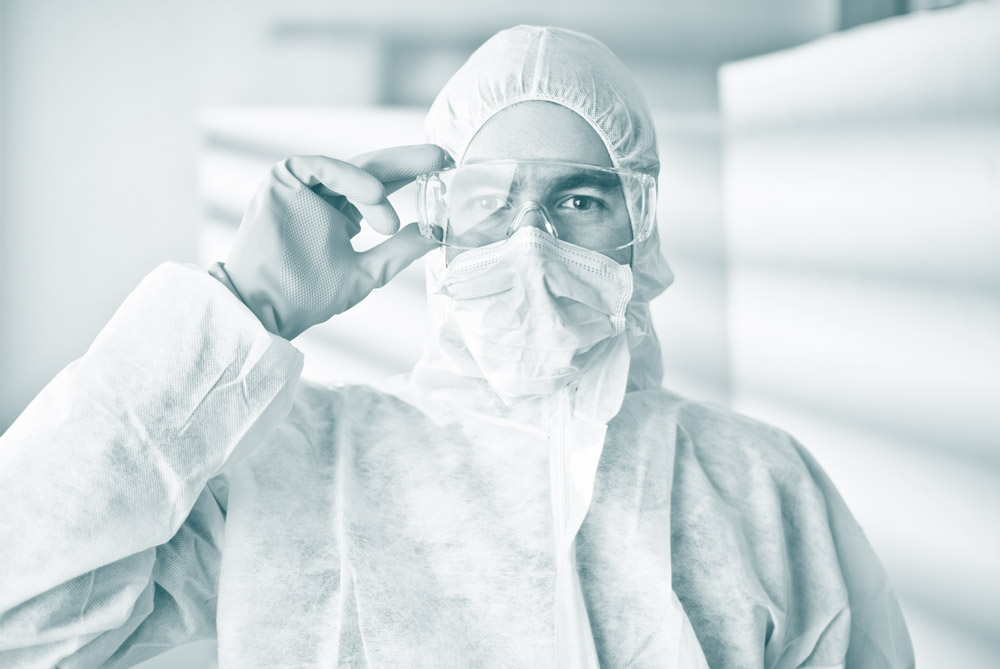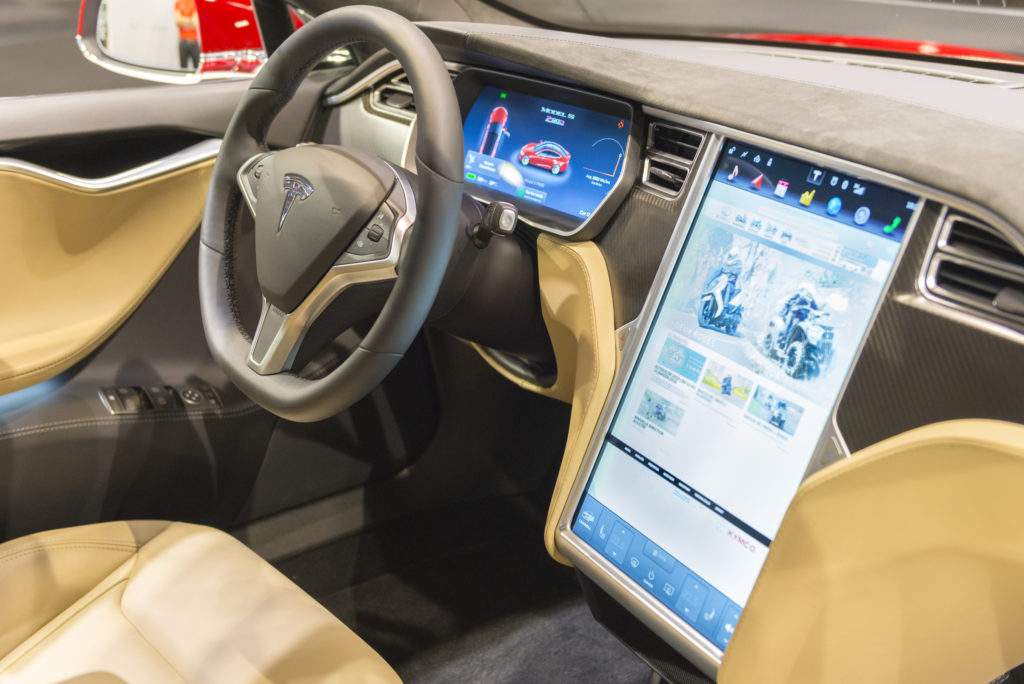Cleanroom News, Robots
Keeping our Hands on the Wheel – Should We Resist the Rise of the Robots?
Last week, in tracing the rise of the robot in the cleanroom, we looked back in time to the roots of automation in the late nineteenth/early twentieth century’s ‘Second Industrial Revolution.’ And it got us thinking. What could be the future of robots in the cleanroom? In controlled environments? In our everyday lives? Could they work hand in glove with humans? Could automation be integrated into the kind of routine tasks that we perform now without much thought? We decided to peek into the future – one none too far away – by spotlighting a big name, some say maverick, company that’s using robot technology not only in its manufacturing SOPs but also inserting them into our lives. Whether we like it or not…
Let’s set the scene. The year is 2084 and a construction worker on a much-needed vacation takes a cab to a rendezvous. The taxi is driven by an automated human-like robot whose overly chipper and slightly sarcastic demeanor give away his robot origins even more than his angular, plasticized profile. Welcome to the Johnny Cab. Now let’s shift our timeframe again and blast still further into the future. In 2263, a cab driver, Major Korben Dallas, becomes the unwitting key figure in an epic battle of Good versus Evil, the outcome of which will determine the whole future of mankind.
Yes, these are Hollywood portrayals of putative science fictional futures. And interestingly, although the plots, timeframes, characters, and story arcs are very different from one another, movies like Total Recall and The Fifth Element (not to mention other iconic sci-fi classics such as Minority Report, I-Robot, Demolition Man, and The Sixth Day) share certain tropes that position the narrative firmly in the future. One of the most popular and useful being that of the automated or self-driving vehicle. Director Paul Verhoeven’s vision in Total Recall saw all Johnny Cabs equipped with a robot ‘driver’ which interacted with the passenger in a highly human way. In contrast, Luc Besson’s dystopian The Fifth Element used human drivers at the controls of the taxi, with an advanced, quasi-autonomous auto-pilot system commonly engaged.
But outside of Hollywood, even in our technologically advanced 21st century world, driverless automobiles remain a distant dream. And even as we pack ever increasing numbers of cars onto our beleaguered freeways and highways each year, the vast majority of them still require a human driver at the wheel.
Unless, that is, you happen to be a Tesla owner.
In 2010, Tesla purchased a property formerly belonging to General Motors and Toyota’s New United Motor Manufacturing Inc. (‘NUMMI’) in Fremont, California, and – inspired by founder Elon Musk’s other high profile project, SpaceX – proceeded to turn the 5.3 million square feet of manufacturing space into a world-class production center that looked to all intents and purposes like the inside of a laboratory. And the decision to create a bright, white, and clean environment that suggested nothing less than a gigantic cleanroom was a deliberate one. In shaping this environment in which to build their Model S, the world’s first semi-autonomous (aka self-driving) car, the company’s unspoken message was abundantly clear: ‘if it looks clean and it feels clean, build quality will reflect that.’(1) In other words, for this ground-breaking vehicle, ultra performance and exquisite attention to detail were the name of the game inside Tesla’s enormous cleanroom.
An important part of this new environment was the incorporation of the now iconic ‘red robots’ that worked on the production line alongside their human counterparts. Visually arresting against the clinical white sterility of the plant, the robots worked on tasks that demanded the highest levels of quality assurance combined with precision and absolute efficiency where human operators could be prone to error or fatigue. And if Tesla’s stock price was a metric, this proved to be a winning formula.
Fast-forward to 2014 and Tesla moved another step closer to fully integrating robots with humans in its acquisition of a 431,000 square foot facility in Lathrop, California. Too small to be used for fuel cell production, the Lathrop site was permitted for machining and CNC. CNC? That’s Computer Numeric Control – machines that perform precise, accurate, repeatable, and identical operations according to a pre-programmed algorithm. In Tesla’s world, examples of tasks requiring CNC machine automation would include cutting, welding, 3D printing, hardening, drilling, assembly, or grinding. In other words, tasks that can ideally be performed by robots.
But production automation is only part of the equation. Alongside a comparatively hefty price sticker, Tesla vehicles are famous for one thing: their autonomy on the highway. In debuting their first self-driving vehicle, the Model S, Tesla ‘vigorously marketed [the auto-pilot technology] as safe and important to its customers.’(2) This technology used intelligent systems to auto-steer by reading lane markings and detecting proximal vehicles, to change lanes, parallel park, and ultimately to slow to a stop and flash its hazard lights if a problem is detected within the vehicle. For the hundreds of thousands of drivers who face interminable daily freeway commutes, the ability to sit back, fingertips casually brushing the steering wheel, and allow the car to get you home sounds like a dream.
But the reality is that this technology still has a long way to go.
In May 2016, the American media engaged in a feeding frenzy when first ‘autopilot’ death occurred. Joshua Brown of Canton, OH, was in the driver’s seat when his Tesla Model S plowed into a tractor-trailer that had made a left turn into his path. It appears that the car’s sensor failed to detect the white-sided obstacle against a bright sky and did not apply the brakes. Tragically, Brown, a Tesla devotee and evangelist, died at the scene.
In the aftermath, the New York Times labeled the incident ‘a wake-up call’ for the self-driving industry (3) and Fortune alleged that Tesla and founder Elon Musk misled shareholders and the public about the role this technology played in the accident.(4) The National Highway Traffic Safety Administration (NHTSA) opened an inquiry, Tesla’s stock price took a (very) temporary nosedive, and many otherwise thoughtful observers managed to completely miss the point.
According to Musk’s figures, Brown’s death was the first in more than 130 million autopilot-engaged miles. And given the rate of over one million auto deaths per year (globally), he shot back that “if anyone bothered to do the math […] they would realize that […] approximately half a million people would have been saved if the Tesla autopilot was universally available.”(5) And even that comment is slightly missing the point.
As drivers, we have the wrong idea about this kind of technology. We romanticize the futuristic vision of the autonomous vehicle conjured by the story-tellers in Hollywood as one over which we need have no direct control. But the reality is that driverless cars are only semi-autonomous, and that modifier is crucially important. As advanced as Tesla’s technology is – and that of Google, Mercedes-Benz, Nissan, Audi, Bosch, and Apple, all of which are testing the limits of self-driving vehicles(6) – it still needs a human to oversee it. Indeed Tesla’s own instructions for the Model S are that drivers should keep their hands on the wheel, at least minimally, at all times. According to some reports, a failure to do this may have been a factor in Brown’s tragic accident.(7)
If robots and automation are to be as successful in our everyday lives as they are becoming within the cleanroom and manufacturing environments, we need to re-frame our perspective. In the airline industry, for instance, it is widely acknowledged that a public misperception exists regarding the role of autopilot in commercial aviation. In his engaging blog, Ask the Pilot, Captain Patrick Smith, an active airline pilot, draws a clear distinction between automated and human capabilities.
“Essentially, high-tech cockpit equipment assists pilots in the way that high-tech medical equipment assists physicians and surgeons. It has vastly improved their capabilities, but it by no means diminishes the experience and skill required to perform at that level and has not come remotely close to rendering them redundant. A plane is as able to fly itself about as much as the modern operating room can perform an operation by itself.”(8)
Robot automation will never replace human intelligence. We can never cede our own personal responsibility to sensors and algorithms, programs and logic. We may be able to shift some of our tasks to automation – whether in the laboratory, the cleanroom, or the driver’s seat – but, while embracing the possibilities of this new technology, we must recognize its current limitations. As Smith concludes, we do not have to be “against the advance of technology [merely] against foolish extrapolations of it.”(9)
Do you welcome the integration of robots and automated processes in your daily life? Would you feel safe in a driverless car? Share your thoughts in the comments below – as real-life human beings, we love to get your feedback!
References:
- http://www.wired.com/2013/07/the-window-tesla/
- http://fortune.com/2016/07/05/elon-musk-tesla-autopilot-stock-sale/
- http://www.nytimes.com/2016/07/01/business/self-driving-tesla-fatal-crash-investigation.html?_r=0
- http://fortune.com/2016/07/05/elon-musk-tesla-autopilot-stock-sale/
- http://fortune.com/2016/07/05/elon-musk-tesla-autopilot-stock-sale/
- http://www.bankrate.com/finance/auto/companies-testing-driverless-cars-1.aspx
- https://www.theguardian.com/technology/2016/jul/01/tesla-driver-killed-autopilot-self-driving-car-harry-potter
- http://www.askthepilot.com/questionanswers/automation-myths/
- http://www.askthepilot.com/questionanswers/automation-myths/
Additional materials:
- http://www.wsj.com/articles/tesla-has-no-plans-to-disable-autopilot-feature-in-its-cars-1468340310
- https://www.tesla.com/factory
- http://insideevs.com/tesla-acquires-431000-square-foot-facility-lathrop-california-begins-manufacturing-modifications-site/
- http://www.sfgate.com/business/article/Tesla-says-it-hasn-t-been-informed-of-SEC-8352979.php
- http://mashable.com/2016/07/11/elon-musk-masterplan/?utm_campaign=mash-prod-synd-apple-all-full&utm_cid=mash-prod-synd-apple-all-full#DOyQzK9Nh5qn
- http://www.robotics.org/content-detail.cfm/Industrial-Robotics-Industry-Insights/Robotics-in-2014-Market-Diversity-Cobots-and-Global-Investment/content_id/4614
- https://transportevolved.com/2016/06/27/in-reno-nv-tesla-gets-permits-needed-to-start-cell-production-expand-gigafactory-to-include-fifth-section/
- http://www.forbes.com/sites/briansolomon/2016/06/30/the-first-self-driving-car-death-launches-tesla-investigation/#3b655b1d62d0
- http://www.vanityfair.com/news/2016/07/how-the-media-screwed-up-the-fatal-tesla-accident






















Pingback: Mantener nuestras manos en el volante - Debemos resistir a la emergencia de los robots? - Productos Para Cuartos Limpios|Berkshire Mexico
It’s a real pleasure to find someone who can think like that
Pingback: CubeSats? - In Space Exploration, Less Just May Be More. - Cleanroom News | Berkshire Corporation
Pingback: Flying High – The Role of the Cleanroom in the Development of Flying Cars - Cleanroom News | Berkshire Corporation